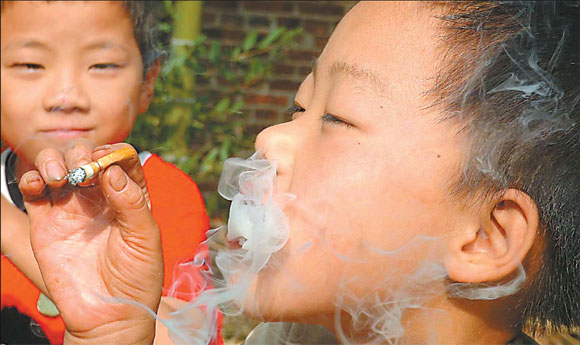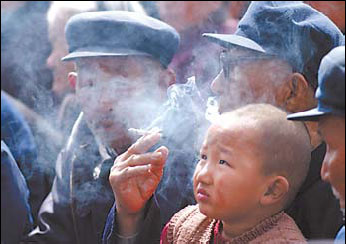Lost in the haze
|
It is not rare to see children smoking in the countryside of Shaoyang, Hunan Province. Teenage smoking is raising questions about the health of the nation's new generation. Li Aimin |
In a country where the saying "a cigarette after a meal makes you happier than gods in heaven" seems to be on the lips of 350 million smokers, could images of skulls and bones scare teenagers from lighting up?
A few hours after China's major portal website www.sohu.com posted an online survey, thousands of people joined the debate on whether to print warning illustrations on cigarette packages that may help deter teenage smokers.
Teen smoking is raising questions about the health of the nation's new generation. Some 18 million children under 15 are exposed to a smoking environment.
The suggestion to print warning illustrations was raised by Professor Ma Jun with the Research Center of Children and Teenager Health at Peking University, who conducted a survey with over 100,000 students that revealed middle school smokers on average took their first puff before 11. Professor Ma called for action in the annual meeting of the China Association for Science and Technology held recently in Beijing.
"Many teenagers are fascinated by skull illustrations, such as the cool and unique skeletons on Disney's 'Nightmare Before Christmas' products. Some of them even have the skull image tattooed on their skin. So how can they be deterred by skulls on cigarette packings?" an anonymous Sohu netizen wrote.
|
Thirteen-year-old twin brothers from Shaoyang County, Hunan Province, decide to quit smoking after eight years of smoking. Li Aimin |
Another netizen criticized this measure for being superficial, attributing the increase in smoking to the lack of anti-smoking social consensus in society at large. "Just like many rich families have fat kids because they don't regard obesity as a problem, many Chinese smoke because they don't take seriously the danger of smoking."
Teenagers in China generally have a father who smokes, attend a school where many teachers light up in the corridor during breaks, and watch movies in which the hero is a chain smoker.
Over half of the teenagers are exposed to secondhand smoke in public places and the proportion is 43.9 percent of teenagers at home.
With so many smokers, Chinese teenagers often get cigarettes from their friends or elders, or they can buy them in shops without a hassle.
Chinese laws forbid young people from entering Internet bars, but there was no legislation that called for punishment against those who sell cigarettes to juveniles until the amendment of the Law on the Protection of Minors took effect in June of this year.
The law, revised late last year, also introduced a new regulation that requires all shops to set up notices and not to sell cigarettes and spirits to minors. It's unclear who will enforce the regulation.
Shopkeeper Lu Peng says his headache is how to identify minors not dressed in school uniforms. "You know, nowadays the kids look quite mature," Lu says, "What can I do? Ask every customer to show me their ID card?"
Another shopkeeper, Zhang Chao, says he generally receives teenagers who come for a pack of cigarettes because more often than not they are running an errand for their father.
"If the father smokes in front of his kid everyday, the kid will think smoking is natural," says Ma.
However, Ma's protest seems to be drowned out by an army of male smokers in China - a stunning 57 percent of the country's male population are smokers.
China is the jackpot of the tobacco industry. Companies within this monopoly industry have occupied one-fifth of the seats in 2006's Top 500 taxpayers in China, from among all companies in 40 major industries. And the tobacco industry continues to be the biggest tax contributor in the ranking. The industry generated a 2 trillion yuan ($263 billion) pre-tax profit in the first half of 2007.
The industry reaps its profits not only from smokers. Many Chinese buy expensive brands like "Zhonghua" (China) and "Panda" as presents for their bosses or parents as these brands are regarded as the symbol of a better-off status. As a social courtesy, they offer a cup of tea, as well as a cigarette, to a male friend visiting their home.
A popular Chinese tobacco brand even takes its name after the location of the central government, Zhongnanhai. It encourages smokers to consume more cigarettes for a good cause. The slogan on the neat blue-and-white package reads, "for each pack you consume, you are devoting your part to the charity Hope Project."
Printing illustrations of skulls and bones or photos of disease-stricken organs on cigarette packages is a goal of the international anti-smoking effort, the Framework Convention on Tobacco Control, initiated by the World Health Organization which China signed in 2003.
|
Many children like this young kid in China grow up with a smoking father, or grandfather. They are exposed to the damage of secondhand smoke both at home and in public places.Tong Jiang |
Such practice is common in many countries such as Canada, Singapore, Thailand and Brazil, while China only demands a small line: "smoking damages your health," on the side of the cigarette pack.
Although government regulations say that smoking is prohibited in public places, many non-smokers are reluctant to interfere with smokers.
To tackle this issue, Beijing lawyer Tong Lihua united lawyers from around the country to use legal means.
Tong followed a practice common in the United States and other countries and that was to sue tobacco companies. They filed a "class action" suit with the plaintiff being a 17-year-old teenager surnamed Yan against 24 tobacco companies and the State Tobacco Monopoly Administration for failing to disclose the damages of tobacco. The suit demanded the use of warning messages on the website homepages of the defendants and also asked that 10 percent of the defendants' websites be dedicated to anti-smoking information. But the court refused to hear the case.
The figures from the Ministry reveal of Health that nearly one million Chinese die of smoking-related diseases every year.
Tong believes that the most effective way to slash teenage smoking is through legislation. "Teenage smoking is an unavoidable question for a responsible government," he says.
Now that the amendment of Law on the Protection of Minors has been completed, the next stage is for local governments to work out local regulations specifying the detailed punitive measures for selling cigarettes to minors. Tong suggests severe punishment for shops that violate the laws, in addition to fines of up to 2,000 yuan ($263) and the suspension of the business license.
China's tax rate on the tobacco industry is below 50 percent, far less than that in developed countries ranging from 60 to 90 percent.
"Why do European and American countries impose stern regulations to crack down on teenage smoking? Because the country's future is at stake," says Tong, "I don't want our children to grow into a generation of 'the sick man of Asia.'"
(China Daily 10/10/2007 page18)

















